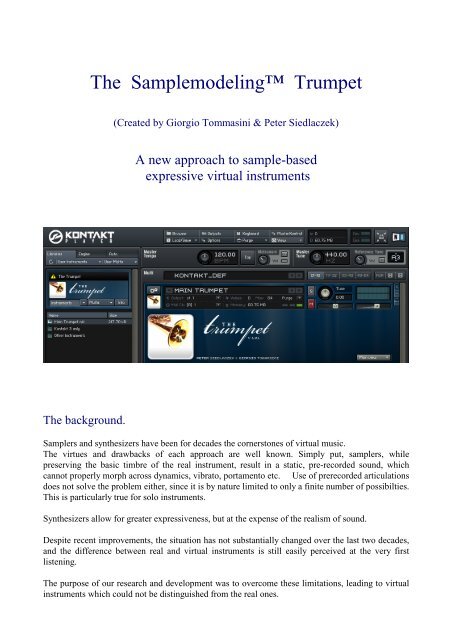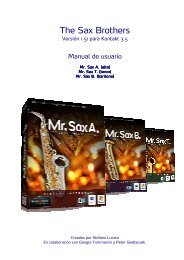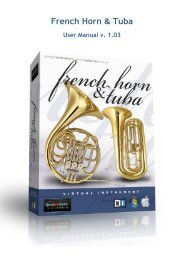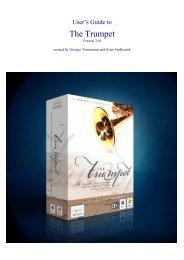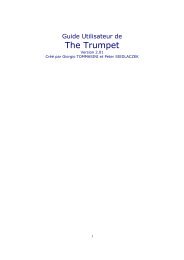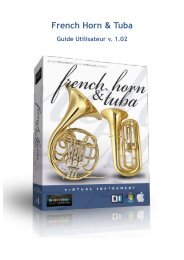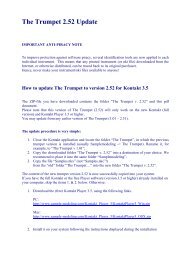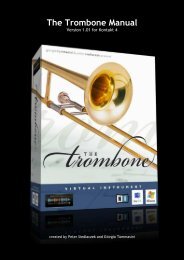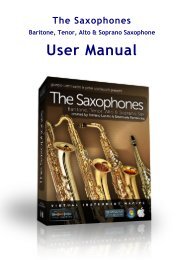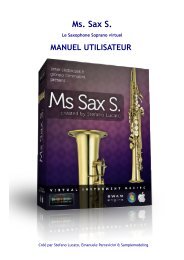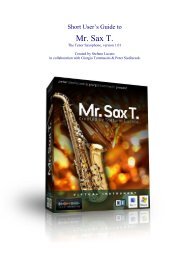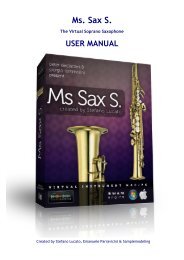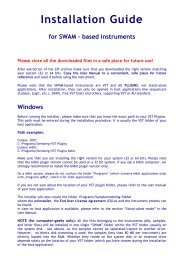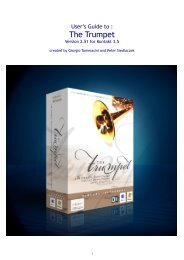Trumpet Presentation - Sample Modeling
Trumpet Presentation - Sample Modeling
Trumpet Presentation - Sample Modeling
Create successful ePaper yourself
Turn your PDF publications into a flip-book with our unique Google optimized e-Paper software.
The <strong>Sample</strong>modeling <strong>Trumpet</strong><br />
(Created by Giorgio Tommasini & Peter Siedlaczek)<br />
A new approach to sample-based<br />
expressive virtual instruments<br />
The background.<br />
<strong>Sample</strong>rs and synthesizers have been for decades the cornerstones of virtual music.<br />
The virtues and drawbacks of each approach are well known. Simply put, samplers, while<br />
preserving the basic timbre of the real instrument, result in a static, pre-recorded sound, which<br />
cannot properly morph across dynamics, vibrato, portamento etc. Use of prerecorded articulations<br />
does not solve the problem either, since it is by nature limited to only a finite number of possibilties.<br />
This is particularly true for solo instruments.<br />
Synthesizers allow for greater expressiveness, but at the expense of the realism of sound.<br />
Despite recent improvements, the situation has not substantially changed over the last two decades,<br />
and the difference between real and virtual instruments is still easily perceived at the very first<br />
listening.<br />
The purpose of our research and development was to overcome these limitations, leading to virtual<br />
instruments which could not be distinguished from the real ones.
1<br />
This has been achieved by our <strong>Sample</strong> <strong>Modeling</strong> approach.<br />
Identification of the "fingerprints" of high quality instruments has been carried out by state-of-the<br />
art recordings of chromatically sampled notes, played by an excellent musician in an anechoic<br />
environment. Typical articulations and expressive phrases were also recorded for analysis purpose.<br />
An "adaptive model", based on the physical properties of the instrument, and exploiting the<br />
knowledge of the performance characteristics was then constructed. The purpose of the model was<br />
to minimize the differences between the real phrases and those played by the virtual instrument.<br />
Sophisticated technologies, including proprietary "harmonic alignment" (ref.1), de/reconvolution<br />
with modal resonances (ref.2), innovative techniques for sample modulation, along with advanced<br />
Artificial Intelligence midi processing, are used for real time construction of all articulations and<br />
morphing across dynamics, vibrato, legato and portamento.<br />
The result is an user-friendly virtual instrument with few midi controllers, which can be played in<br />
real time or from a sequencer, in standalone mode or as a plugin, for PC or Mac.<br />
The played phrases are now virtually indistinguishable from the real thing.<br />
Besides, it's a great fun to play.<br />
References<br />
1) "Time alignment of the phase of a set of musical sounds to be used with samplers" . Patent-pending. Filed by Giorgio Tommasini,<br />
as of September 23th 2004.<br />
2) "Determination of modal resonances and body impulse response of a musical instrument by analysis of sounds performed with<br />
pitch changes. Application to the synthesis of vibrato & portamento with samplers". Patent-pending. Filed by Giorgio Tommasini<br />
and Stefano Lucato, as of December 20th 2004.<br />
Technical notes<br />
This is not a library, and no additional sampler or player is needed. The <strong>Trumpet</strong> is a Kontakt Player<br />
2 Virtual Instrument, working either standalone, or as a plugin (VST or RTAS for the PC) and VST,<br />
RTAS or AU for Mac. It employs (and requires) state-of-the-art technology. The instrument has<br />
been developed and thoroughly tested on a PC with IntelCore2 6600 & 2.40 Ghz, 2GB RAM,<br />
Windows XP, 2 SATA drives, a 24 bit audio card with low latency (
2<br />
Features<br />
A complete set of instruments in a single package<br />
The set consists of seven instruments belonging to the same family:<br />
Three different Bb trumpets, suitable for solo or sections.<br />
Cornet, Flügelhorn, German and Piccolo <strong>Trumpet</strong>.<br />
Continuous, seamless transitions across the full dynamic range<br />
As implemented in the Stradivari Violin and the Gofriller cello, our “harmonic alignment”<br />
technology allows for real-time, continuous morphing from ppp to fff while the note is being<br />
played, with no phasing artifacts.<br />
Continuous control of vibrato intensity and rate<br />
De/reconvolution with the modal resonances of the instruments, coupled with advanced sample<br />
modulation techniques, allow for very realistic vibrato, with continuous, real time control of vibrato<br />
intensity and rate.<br />
Realistic pitchbend effects<br />
The pitchwheel allows for very realistic effects. Nonlinear mapping to +/- two semitone allows for<br />
precise tune control in the middle range, but extends to +/- two semitones towards the extremes.<br />
This, coupled with spectral morphing and transitional flutter, allows for very typical articulations,<br />
ranging from manual vibrato, to a full shake of any shape.<br />
Modeled transitions<br />
Our exclusive adaptive model allows for easily obtained transitions and phrasing, which sound<br />
indistinguishable from the real instrument: sforzato, crescendo, decrescendo, legato/portamento,<br />
semi-legato, forced staccato, shakes, vibrato-like endings, wah-wah, split portamenti, falls and much<br />
more.<br />
Mutes<br />
The three Bb trumpets may be played with several mutes, including Straight, Bucket, Cup, Harmon<br />
(with or without Stem). Two different plungers are also available for wah-wah effects.<br />
2
3<br />
Special Features<br />
Velocity Remapping<br />
It is well known that midi keyboards have different and uneven velocity response, and this may<br />
heavily influence the performance of a virtual instrument. To obviate this problem the instrument<br />
includes automatic detection of any velocity inhomogeneities or non-linearity emitted by the<br />
keyboard, and provides automatic remapping to any desired curve. Remapping of some midi<br />
controllers is also provided. This allows for example to remap CC7 to CC11, allowing for use of<br />
some high quality, but older keyboards which could output only CC7. Remapping of CC2 to CC11<br />
allows for use of a breath controller, such as Yamaha BC3, provided that your keyboard supports it.<br />
GUI Knobs<br />
All the controllers needed for proper functioning of the instrument are mapped to virtual knobs in a<br />
GUI panel, which can be activated by a drop down menu. This allows those users with keyboards<br />
without programmable MIDI sliders or knobs, to fully exploit the expressive capabilities of the<br />
instrument. The virtual knobs also allow for monitoring the incoming midi data, and can of course<br />
be automated when used as a plugin in an appropriate host application.<br />
Performance Keyswitches<br />
This is an outstanding new feature, allowing to create real time articulations which are too difficult<br />
to perform with the usual interplay of expression pedal, pitchbend and modwheel. Sforzato,<br />
crescendo, decrescendo, on-the-fly complex modulation patterns and different types of release, can<br />
be obtained by a simple touch on one of the keyswitches. The intensity of the effect, and its<br />
duration, are under player’s control. Please note that these are not just sampled articulations, but<br />
they are sample-modeled, indeed. This means that each time each of them will sound slightly<br />
different. No machine-gun nor mechanical repetitions here.<br />
Split Portamentos and Falls<br />
A real trumpet may play different types of legato/portamento, with or without valves. The sound is<br />
different, since a different harmonic resonance is excited. This is nicely reproduced by our adaptive<br />
model. One may choose to perform a continuous half-valve portamento over two octaves by simply<br />
overlapping two notes, to split it manually playing intermediate legato notes, or to split it<br />
automatically, exploiting the natural harmonic resonances of the instrument, using a single<br />
keyswitch. One can even choose to perform chromatically-split portamento or automated falls. Six<br />
different split portamento types and four different falls are activated by the touch of a keyswitch.<br />
Wah-wah effect<br />
The wah-wah effect is usually elicited by moving a plunger inside the bell. A very realistic<br />
reproduction of this effect is carried out by a simple touch on a keyswitch, with continuous control<br />
of the wah-wah intensity given by the expression pedal.<br />
3
4<br />
About the Developers<br />
Giorgio Tommasini holds a medical degree "magna cum laude" from<br />
Milano University, and had an illustrious career as a clinical cardiologist,<br />
researcher, and head of the Cardiovascular Division of a 400-bed<br />
Hospital. His pioneering research, mainly oriented on applications of<br />
computers in cardiology, and witnessed by more than 150 scientific<br />
papers, patents and presentations at internationational Meetings, led to<br />
new methods for quantification and treatment of myocardial infarction,<br />
new techniques for detection of silent ischemia and automatic<br />
quantification of coronary narrowings by intelligent image processing,<br />
and the invention of a revolutionary, 3D approach to coronary<br />
angiography. More recently, his research was devoted to the<br />
development of new strategies for relieving pain and anxiety in the<br />
setting of acute and chronic diseases.<br />
As a musician, he played guitar and bass in various groups of the fabulous Sixties. He became<br />
interested in samplers as accompaniment for his music in the mid 1980's. Very unsatisfied by the<br />
lack of expressiveness of all available sample-based instruments, he began to think of methods<br />
capable to overcome this limitation. The "Harmonic alignment technique", and the "Determination<br />
of modal resonances and the impulse response of an instrument by analysis of pitched sounds" (in<br />
collaboration with Stefano Lucato), were the first results of this new research in an entirely different<br />
field. For the first time it was possible to crossfade from pp to ff , and from senza vibrato to vibrato,<br />
with continuity and no phase artifacts. These techniques were applied to "The Stradivari Violin",<br />
and "The Gofriller Cello", created in collaboration with Stefano Lucato and Gary Garritan.<br />
Peter Siedlaczek graduated with honors as a tonmeister from the<br />
Chopin Academy of Music in Warsaw, where he stayed on to teach<br />
studio technology, taking part in numerous research projects in<br />
acoustics and psycho-acoustics. Prior to that - still as a teenager - he<br />
followed two courses of study: while earning a diploma in electronics<br />
at the technical high school, he also completed his diploma at the<br />
music high school as a promising pianist, who even as a student<br />
enjoyed numerous successes. After moving to Germany, he has<br />
contributed as a well-respected sound engineer to many German chart<br />
hits. As a producer, he reached the Top Ten of the American Billboard<br />
club play charts, as a sound designer he set new standards in classical<br />
orchestral sampling. He created sound libraries such as Advanced<br />
Orchestra, Classical Choir, Total Piano, Smart Violins and Orchestral<br />
Colours appreciated around the globe. With a sure feeling for pop music and jazz, and his<br />
undisputed talent for and experience with classical music, Siedlaczek has specialized in complex<br />
orchestral productions, which he undertakes for film production companies, advertising agencies<br />
and record companies.<br />
4
5<br />
Company information and Contacts:<br />
Please refer to our website :<br />
www.samplemodeling.com<br />
Acknowledgements<br />
The <strong>Trumpet</strong> is the result of a many-year research carried out by Giorgio Tommasini and Peter<br />
Siedlaczek, who also performed all the recordings. The K2 script was written by Nils Liberg, Josef<br />
Natterer and Giorgio Tommasini. We are also much indebted to Stefano Lucato for his pioneering<br />
co-research work, helpful suggestions and constructive criticism.<br />
Special thanks to:<br />
Maciej Mulawa for the wonderful demos and Axel Schlosser for his great cooperation and skillful<br />
trumpet performance (Axel plays his custom-built trumpet created by the award-winning<br />
manufacturer Klaus Martens).<br />
Victor Emerson, Roberto Soggetti, Fabio Vicentini and Torsten Kamps for excellent beta testing,<br />
benchmarking, helpful advice and fantastic demos.<br />
Thanks also to Arnd Kaiser of Steinberg (Cubase), Steffen Holly and Andre Standke of Magix<br />
(Sequoia) and Burkhard Elsner of Mega Audio (DPA Microphones) for their excellent cooperation<br />
and support.<br />
5


